The Real Jurassic Park: Geological Explorations in Southwest England
University of Washington, Tacoma
TESC 417: Summer 2006
The Real Jurassic Park: Geology field course along the south coast of England (TESC 417)
Home
Location: Lyme Regis (Church Cliffs)
Introduction:
On Monday evening, July 31st, we arrived at the historic town of Lyme Regis which is located in Dorset and is surrounded by beautiful coastlines and countryside..
The town is a haven for fossil lovers and the was home of Mary Anning, described
as "the greatest fossilist who ever lived." (Brunsden, 36). Lyme Regis is at the heart of the Jurassic Coast. It overlooks Lyme Bay and is a quaint town with narrow,
twisting streets and Georgian houses. It dates back to 774 AD when the West Saxons allowed the local monks the privilege to extract salt from the sea water. During
the 18th century it became know as a very fashionable seaside resort where Jane Austen visited and whose setting she included in one of her novels. Today it is a bustling
tourist town, complete with carnivals, museums and stunning views. (Brunsden, 36)
Detail Map:
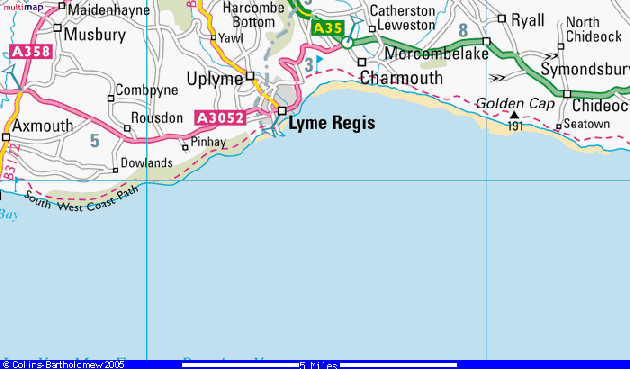
Highlights:
Lyme Regis had two wonderful museums, Dinosaurland
Fossil Museum, which we visited as a class on August 1st, and the Philpot Museum, which we visted on our own. They were both well worth the time spent. Dinosaurland was a treasure
house of fossils--it showed an enormous collection of maps, history and local Jurassic marine fossils including the Ichthyosaur, ammonites, belemnites, fish and starfish.
The Philpot (Lyme Regis) Museum exhibits a collection of local historic and martime artifacts and fossils, the life of Mary Anning, and much more and was housed in a marine
fashioned building constructed in 1900 by Thomas Philpot. The building alone is worth the visit.
Along with fossil hunting, Lyme Regis is well-known for the famous Mary Anning who lived her entire life in Lyme Regis--from 1799-1847.
She collected fossils around Lyme Regis (and also Charmouth) when she was just a child. She collected with her father and brother, and at the age of 11 when her
father died, she took over fossil-hunting business. Although she had no formal education, she became an extremely skilled collector and had a very impressive knowledge
of anatomy. Mary and her family are responsible for finding the first ichthyosaur around 1814, the first complete plesiosaur in 1824, and the first flying reptile found in England.
Her fossils, history and her hammer can be viewed at the Philpot Lyme Regis Museum. The Natural History Museum in London also houses her discoveries. She collected
fossils amost 200 years ago, and today, it still remains an important part of life along the Jurassic World Heritage Site.
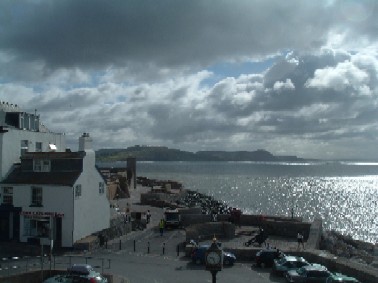
Lyme Regis, early evening. View looking east from Cobb Gate. Mary Anning lived a little ways east of the fish bar (white building).
Synopsis of Area:
Lyme Regis lies in a clay valley between two spurs of Upper Greensand and Chalk. The town and river valley are located in a syncline of Liassic clays, Shales-with-Beef and Black Ven Marls.
(The Shales-with-Beef actually looked like beef.) The cliffs surrounding the town are composed of Blue Lias limestone which is much harder than the soft clays.
The tops of the hills in this area consist of a brownish-green Upper Greensand with chert and Chalk and were deposited during the Cretaceous age--about 100 million years old.
Under this layer is grey Liassic marine clays from the Lower Jurassic age--approximately 150 million years old. These clays contain belemnite and
ammonite fossils which are prevelant in Lyme Regis. Occassionally an ichthyosaur or a plesiosaurs fossil will be found. This sequence of Cretaceous sand
and chalk on top of the Jurassic clay has caused many problems with landslides in Lyme Regis. (West, Lyme Regis)
On August 2nd, Dr. Dorthy Satterfield and Dr. Roger Suthren, both geologists from the University of Derby, joined us out in the field at Lyme Regis to lend their expertise and provide us with an introduction
to paleoecology and sedimentology. We explored the beaches along Church Cliffs with them and learned about the Lowest part of the Jurassic age and all that it could teach us.
We looked at Belemnite Marls, Black Ven Marls, Shales with Beef, Blue Lias and countless fossils.
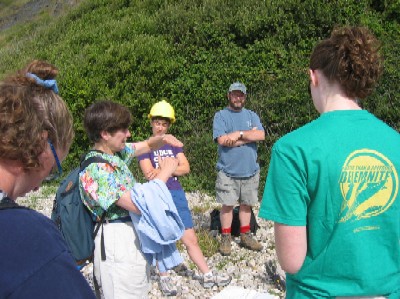
Dr. Dorothy Satterfield and Dr. Roger Suthren, from the University of Derby--geologists who joined us out in the field to lend their expertise
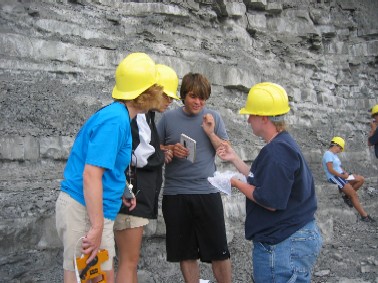 Liz, Lisa, and Daniel stand in amazement at Alison's major find--maybe it's an ammonite fossil!
Liz, Lisa, and Daniel stand in amazement at Alison's major find--maybe it's an ammonite fossil!
Lyme Regis is set below steep hills overlooking Lyme Bay--construction is underway to keep the hill from sliding into the sea.
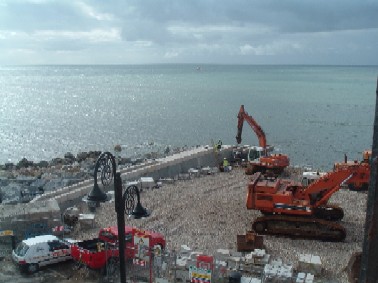 Saving Lyme Regis
Saving Lyme Regis
Summary:
Topics of study at Lyme Regis were: Historical geology, palentology, paleoecology and sedimentology. These included class sessions with Dr. Dorothy Satterfield and Dr. Roger Suthren focusing on
paleocology and sedimentology. Upon arriving at Lyme Regis, we first headed for our lodgings--we settled into
Woodbury Down, got used to the bunk beds and the shared bathrooms--we were, after all,
seasoned travelers by this time and learning to go with the flow. We had buffet syle breakfasts and dinners and generally a packed lunch to take with us on or excursions. We enjoyed
free time in the evenings after class and usually went to town which was a real treat. Lyme Regis is a wonderful, historic town with great shops to wander and see local treasures,
friendly people and a great place to enjoy cream tea or conversation in one of the pubs. We spent six nights in Lyme Regis and were lucky enough
to be there for an annual carnival--complete with great fireworks that were set off over the bay, and a live band.
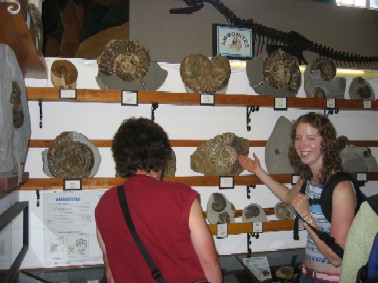 Fossilman Nels and Brienna checking out the local ammonites at Dinosaurland
Fossilman Nels and Brienna checking out the local ammonites at Dinosaurland
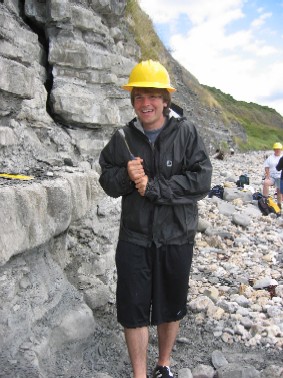 Daniel getting into the swing of things.
Daniel getting into the swing of things.
Links to Related Projects:
Fossil Collecting on the Jurassic Coast. By Nels Parvi
Lyme Regis: No Longer Slipping Away. By Liz Johnson
Mary Anning: Paleontology's Enigmatic First Lady. By Raquel Eriz
Geology and Tourism on the South England Coast. By Jenny Ripatti
Holy Architecture!: Cathedrals, Abbeys, and Parish Churches of Southwest England. By Lisa Green
World Heritage: Conservation Efforts in the United Kingdom and Ireland. By Jeanine Riss
Geology, Landscapes, and Land Use of Dorset and East Devon. By Angus Leger
Other Related Links:
Geology of the Wessex Coast, Southern England by Ian West
References and Acknowledgements:
-- Brunsden, Denys. The Official Guide to the Jurassic Coast, Dorset and East Devon Cost World Heritage Site. Coastal Publishing. Wareham, England, 2003.
-- Dorset: Coast and Countryside, Historic Towns and Villages. J. Salmon, Sevenoaks, Kent, 2006.
-- Detail Map: 2006 Multimap.com. September 2, 2006. http://www.multimap.com
-- Dorset County Council (2006). Jurassic Coast. September 22, 2006. http://www.jurassiccoast.com/index.jsp
-- West, Ian (2005) Lyme Regis September 9, 2006. http://www.soton.ac.uk/~imw/Lyme-Regis-town.htm
Home



 Liz, Lisa, and Daniel stand in amazement at Alison's major find--maybe it's an ammonite fossil!
Liz, Lisa, and Daniel stand in amazement at Alison's major find--maybe it's an ammonite fossil! Saving Lyme Regis
Saving Lyme Regis Fossilman Nels and Brienna checking out the local ammonites at Dinosaurland
Fossilman Nels and Brienna checking out the local ammonites at Dinosaurland Daniel getting into the swing of things.
Daniel getting into the swing of things.